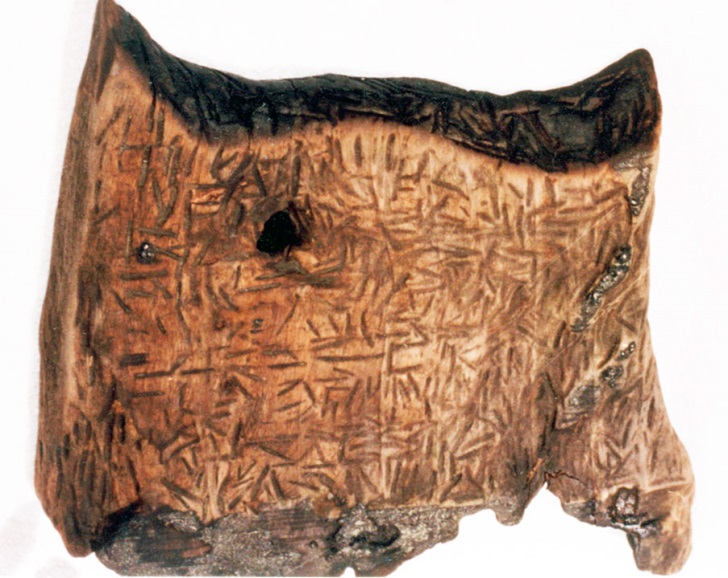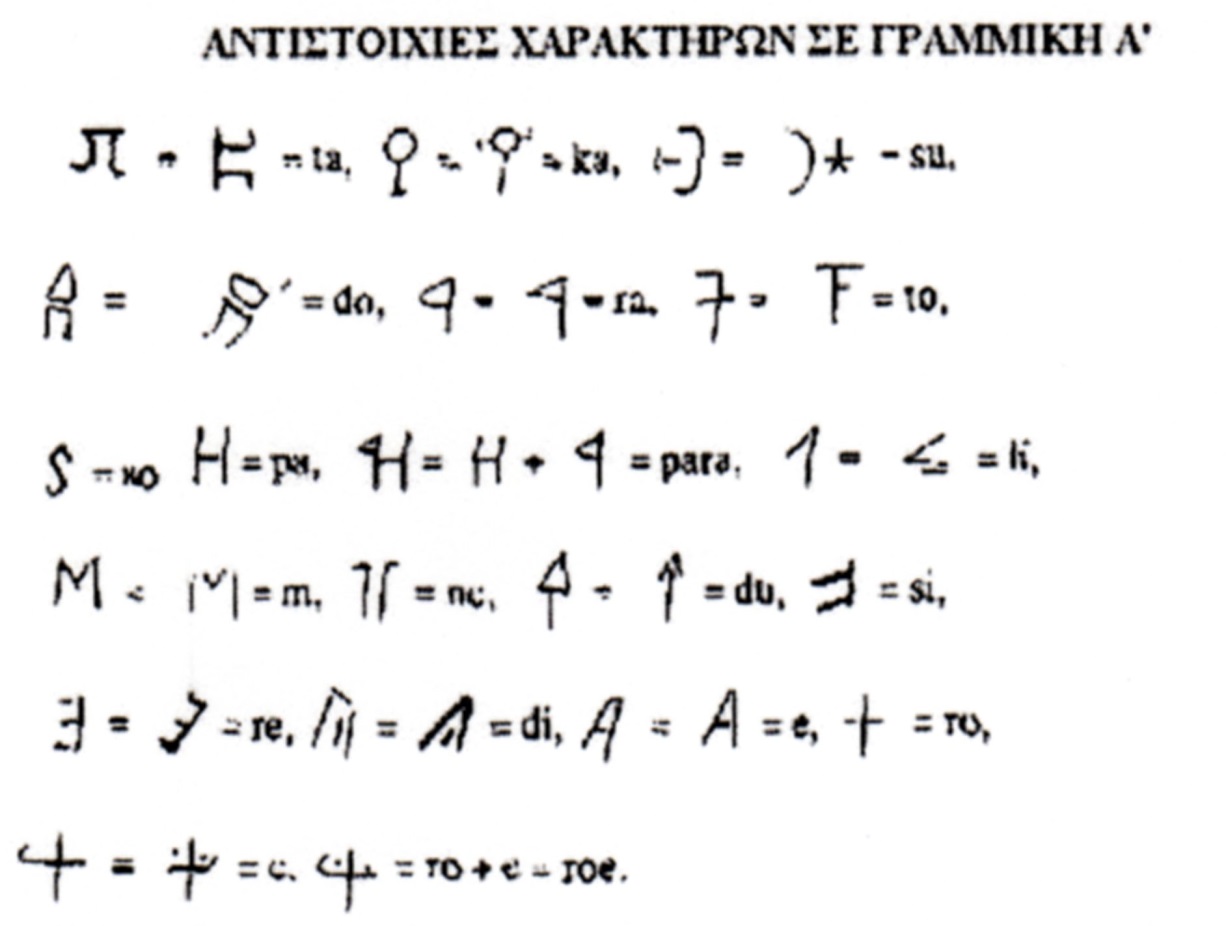THE INSCRIPTION OF DISPILIO
(video available)
The inscription of Dispilio, Kastoria.
I pray for my everyday life.
This is the first written text in Europe. It was found in 1992, during excavations at the lakeside settlement of Dispilio, Kastoria, Greece.
It dates back to 5500 B.C..
THE IMAGE OF THE INSCRIPTION

The text is a prayer to a God of that time.
The text is a document of being in contact with God, through a prayer.
The Professor of Archaeology at the Aristotle University of Thessaloniki, Nikolaos Chourmouziadis, worked on the identification of the phonetic values of the inscription.
What follows is the table of ideograms of the inscription.
These are the ideograms, classified by Professor Chourmouziadis.

This is the table of the correspondence of the characters of the ideograms with Linear A, as it was classified by Professor Chourmouziadis.

We studied the phonetic values in the actual text. We understood it, we read and rendered it into Modern Greek, but we also approached it philosophically.
Identification of the phonetic values of the text.
Correspondence of the ideograms of the text according to the table of the phonetic values above by Chourmouziadis.
E- ro- e- di- re- si- du- no- ma- k- e-ro- ra- pa- ko- to- ro do- su- ka- ta
Figuration of the phonetic values of the text.
In our own view, the phonetic values are formed as follows:
e-ro e-di-re si-du no ma-k, e-ro ra pa ko-to-ro do-su ka ta
Rendition of the text:
Ερώ, εντηρέν και σίντους νοώ μακράν, ερώ, ρα πα κουτουρού να δώσω κάτ’ τάμαν.
The language of the text is Greek, Archaic, typical of any Macedonian text. The grammatical structure of the text is mixed.
One can identify Pontic, Macedonian and Doric words, as well as Classical Greek Language.
The utterance of the words and of the verbal types, follows the grammatical rules of the Pontic and Doric Dialects, as well as those of the Classical Greek Language.
The Τext in Modern Greek:
I wish cunning and devious people would be away from me, I wish of course to give an offering to God,with no previous thought, in order to reap the benefits of his protection.
(Επιθυμώ, πλαγίως ενεργούντα και άρπαγες να τους νιώθω μακριά από εμένα, επιθυμώ βεβαίως καιχωρίς προσχεδιασμό να δώσω κάτι ως τάμα (για την Θεία προστασία).).
Pontic Reading and Rendition in Modern Greek by Chourmouziadis:
Ero: I want, I wish
Edire: Cunning, devious
Sidu: Cunning, devious, greedy
No: I feel them
Mak: Away from me
Ero: I want, I wish
Ra: Of course
Pa: and
Kotoro: With no previous thought
Dosu: To give
Ka: Something
Ta: An offering to God for the benefits of his protection.
A Philosophical Approach:
In 1932, when the Professor of Archaeology Antonis Keramopoulos discovered the lakeside settlement of Dispilio, Kastoria, could not imagine that, sixty years later, in 1992, another Professor of Archaeology, Nikolaos Chourmouziadis along with his colleagues, would bring to light the oldest written document in Europe, in the same place.
As Nikolaos Moutsopoulos, the Professor of the Polytechnic School of the Aristotle University of Thessaloniki participated in these excavations, he was the one who dragged the board from the mire and delivered to us this so important finding.
According to its dating, it is the oldest text in Europe. According to the experts, it was inscribed in 5500 B.C..
It is an old prayer and it proves deep religious feelings and faith in God.
People of the time could construct ships, as a result, they have nautical knowledge.
They inscribe letters, and this means that there is a communication system through the writing discourse.
They pray, so they accept superior powers to which they give offerings.
Cunning people are not accepted, according to their moral values, and they do not want to have any relations with them. As a result, they are a society with behaviour rules and with values.
Their society is not fully moral, as long as greedy people live in it.
Their home is in the water, for reasons of safety and protection. Thus, they have building knowledge and especially they know how to use stakes in order to construct a building.
They also practise the art of fishing.
Fish is part of their diet and they may have cooking knowledge, as well as knowledge about the nutritional value of the protein.
Their writing style is poetic.
It has got meter, intonation, lyricism, and it may be set to music.
The characters of the letters inscribed on the plate is a forerunner and the beginning of the Doric Macedonian Alphabet, the characters, the syntax and the phonetics of which we use nowadays.
Travelling in the era of the myth.
This myth is partially turned to a historical fact, according to the old saying:
The names lead to the truth.
”ο οδηγός προς την αλήθεια η των ονομάτων επίσκεψη”,
It is time that we look for the Pelasgian’s roots, which are authentically greek.
How a Pelasgian is defined
The sunburnt person who brings all his products at home. (Ο πελόμενος (ηλιοκαιόμανος) και εις τον άς (οίκο) άγων το γέννημαν (παραγωγή καρπών, αυτά πουγεννά η γη).) It is the person who is burnt by the sun, while working on his field, and he stores his crops at home. He is the cultivator of the land.
During the flood era, the original Pelasgian becomes a Deucalion: He successfully manages the deluge and he is the master of the sea.
He is obliged to live in the water. There are two ways of dealing with water: Either one can avoid it, living on a mountainous place, or he/she compromises on it.
Apart from farming, a Pelasgian deals with stock-breeding, that is why he visits mountainous places. What he should do, is to protect himself and his stock from the harsh weather conditions. That is the reason why he finds shelter to graiks (γραικ) (big caves).
The Pelasgian who lives in graiks (γραικ), is called Graikos (Γραικός).
When the graiks are overcrowded, a town is formed, called Graikia (Γραικία).
Moreover, the Latin word Greccia means the land of the shepherds.
It is noteworthy that graiks on Crete are called Mitato (Μητάτο). Ιt is made of stone, it has a dome and it is appropriate as a mountain residence. It is interesting and it reminds us of an old myth, the one about Theseus and Ariadne and the Minotaur maybe lived in a graik-Mitato.
Graikos wanders, feeding his animals and living in fertile mountainous valleys, called lacheies (λάχειες). The Graikos who lived in lacheies is called Vlach (Βλάχος) (βιώ-live + Βλάχος +Vlach).
In the Vlach Dialect, the Vlachs were defined as Armoun (Αρμούν) (χαραία-field+μένω-live). I live and wander in fields, a clearly greek expression.
The surface of the Greek land is flooded with the water, even if this surface is rough.
The Sel (Σελ) formed instantly , create small rivers. These rivers may hopefully find an outlet towards the sea, but when lacheies (fertile valleys) are flooded with water, then a new mire is formed.
When a lake exists (ίσταται-exists) on a mountain, it has the name Orestias or Orestiada (Ορεστιάς – Ορεστιάδα). It means the water concentrated on a mountain, after a flooding.
This is the name of the lake of Kastoria, in Western Macedonia. This lake exists on a mountain.
The residents of the area are called Orestai (Ορέσται). Moreover, the name Orestis (Ορέστης) has the meaning of a person living on a mountainous area.
Around the shallow lake there is a mire, and a small surface of land around, while for reasons of protection from the harsh weather conditions and the wild animals, the Pelasgians change their way of living.
They take wooden stakes from the surrounding forests, in order to build towns on the mire.
As I have mentioned above, the Pelasgian has become a Deucalion, who could manage water for reasons of survival.
The person who lives in the middle of the Sel (Σελ) (streams-rivers) and mire (έλος) is called SELLOS (ΣΕΛΛΟΣ).
It is the group of the indigenous Pelasgians, who live and source food from water.
Nowadays, there are Sellos states in different places of the world. The documentaries about the peoples of the East have made us aware about it.
Such a settlement exists in the Prehistoric area of the Orestida-Orestiada lake in Kastoria.
Τhe cedar is the wood of the water. Ιts resin does not allow its decay. That is the reason why our ancestors used to make ships out of resin mainly.
Let’s flash back to the myth again.
The floodings are steadily reduced, until they finally die out. Water rarely falls from the sky, the Sel (Σελ) (streams-rivers) gradually dry, the rivers become more tranquil and the water withdraws.
Laas-las-lithos /Stone, mountain (λαας-λας-λίθος) comes into surface in the middle of the Sel (Σελ).
The land (Λας/Las) coming into surface in the middle of the Sel (Σελ) is called Sellas (Σελλάς), and its residents are called Sellanes. (Σέλλανες).
When Σ is removed, then the land made of stone, existing in the middle of Sel (Σελ) (streams-rivers) and mire (έλος) , is called Hellas (Ελλάς) and its residents Hellenes (Ελλάνιοι-Έλλανες-Έλληνες).
It is not necessary to look for greek tribes who settled in our country. The myth will demonstrate our history, which dates back deeply in time.
The Upper Macedonia (Ano Macedonia/Άνω Μακεδονία) of the past, nowadays called Western Macedonia, owns a part of the History of Europe, thanks to the inscription of Dispilio.
I was granted by God
The right to touch the inscription of Dispilio,
I am happy to make Europeans aware of it,
And to offer them the interpretation of its text
First as a Macedonian and then as a Greek.
(Εμένα που θεία οικονομία προίκισε
την πινακίδα του Δισπηλιού ν’ αγγίξω
την γνώση της πανευτυχής
ως Μακεδόνας πρώτον και ως Έλλην,
του κειμένου τούτου την ερμηνεία
στους συντοπίτες μου Ευρωπαίους χαρίζω).
The keys that unlocked the text are the Doric Macedonian Dialect, as well as the Discourse of the East, which nowadays is called Pontic Dialect.
